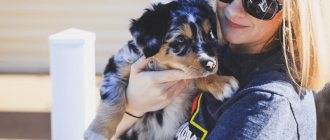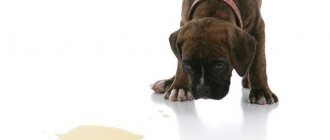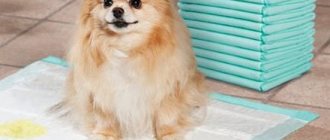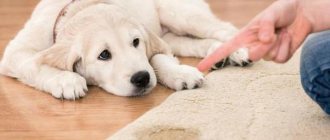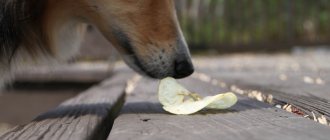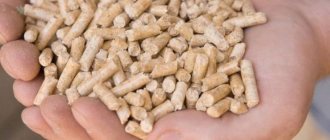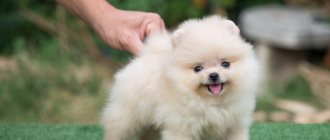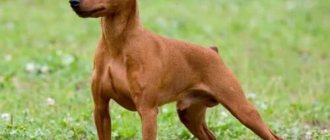When can you take your puppy out for a walk?
It is possible to accustom a dog to the street no earlier than the second vaccination has been given. Otherwise, the baby can easily catch distemper, enteritis, or another dangerous disease in the yard that can lead to the death or disability of the animal.
What to do while the puppy is not allowed to go for walks
While the dog does not leave the apartment, you need to think about how to wean the puppy from peeing anywhere at home. To do this, get him used to a dog diaper. The skill of emptying in a certain place will instill discipline and subsequently make it easier to train the dog to use the toilet outside.
You need to train your dog based on the following rules:
- The puppy never defecates where he sleeps unless there is no other option. When he wakes up, he always moves away from the bed to relieve himself there.
- The dog always defecates immediately after eating or playing actively. Therefore, as soon as he wakes up or calms down after playing, take the baby to the diaper.
- Always praise your baby when he goes to the toilet for a diaper.
- Your pet should always have access to a diaper.
- If your baby urinates in the wrong place, carefully clean the floor using special products. Never poke your dog's nose into urine. This way you injure the baby, which can lead to fear incontinence.
It is necessary to accustom your pet to a diaper no later than 8 weeks. By three months, the dog should be able to find the toilet on its own at home.
How to train a puppy to go to the toilet outside
Today, it’s no longer surprising that dogs go to the toilet, just like cats go to the litter box. And for them, walks are a way out into the world in the arms of their mistress. However, this is more an exception to the rule than the norm, and most four-legged pets still go to the toilet outside.
If the puppy’s quarantine is over (the veterinarian usually warns you about how much time should pass), then training can begin.
The younger the puppy, the more often you will have to take him outside. Until six months of age, this is at least five times a day; after six months, three will be enough.
The most acceptable time to take your pet outside is 15 minutes after eating, after sleep or active play. If the puppy has done everything correctly, then he must hear praise and preferably receive his favorite treat. You can start training, playing and learning only after all the work is done. This is exactly the algorithm of action that a child should learn and know why he is being rewarded.
It is worth considering that at first you will have to walk until the puppy pees and only then return home. Otherwise, the dog will think that it is being taken out to play and run around.
Sometimes it happens that everything is done correctly, and the puppy gets used to the fact that he needs to go to the toilet outside. But now, the pet presents surprise after surprise, forgetting what he was taught. The pet owner is perplexed, what's the matter?
There may be several reasons:
- It is worth knowing that in dogs, urination and defecation are associated with marking territory and are an important part of dog language. Typically, this behavior is associated with estrus in females and a period of sexual activity in males. This is completely understandable behavior and you should not scold your pet, but it is better, if possible, to make walks more frequent.
- An increased urge to defecate may indicate illness in your pet. Most often, the problem is inflammation of the organs of the urinary system, so it is worth showing the dog to a doctor and undergoing basic tests.
- If you switch your pet's diet to dry food during the warm season, he will consume more liquid. And this, in turn, is another reason for frequent toileting.
- Puppies and young animals may urinate when they are scared or overjoyed. This is due to the immaturity of the nervous system, and in most cases this behavior goes away with age. If this does not happen, then it is better to consult a veterinarian or dog handler.
Training a dog to walk is quite a labor-intensive and painstaking task. You will have to be as patient and loyal as possible, because a puppy is a child that requires attention and love. Only the correct behavior of the owner will allow the baby to understand what is required of him and do everything correctly.
Accustoming a puppy to the street
Why do dogs go to the toilet outside? Because they were taught. If this is not done, they will crap at home, which will not lead to anything good.
When the quarantine after vaccination is over, the dog can be taken out into the yard. Before you train your dog to go to the toilet, buy a leash, collar or harness, and muzzle in advance, taking into account the size of the pet, based on the following recommendations:
- The collar must fit snugly on the dog. It should not be squeezing the neck or dangling. If the dog jumps out of the collar, he may run away and, if things go wrong, get hit by a car.
- Buy a leash of at least 2 meters. If it is made in the form of a chain, the links must be strong. When the pet grows up and the chain is too thin, he will break it. If the chain is too thick, it will be difficult for the baby to support its weight, which will have a bad effect on the formation of the skeleton.
- When buying a roulette leash, check its quality. If the button that fixes the length of the leash breaks near the road, the puppy may accidentally throw itself under the car.
- A harness for a puppy is more reliable than a collar. Her choice must be approached carefully. Make sure that the harness is sewn correctly, otherwise it can injure the pet and disrupt the formation of the skeleton.
Where and how to walk
When your pet is on a leash, you can walk with it wherever dogs are allowed - on the street, in a park, in a square. Never let him off leash near the road, even if there are no cars. The dog may suddenly run, or a car may unexpectedly drive out and run over the dog.
You must let your pet off the leash in special areas designed for walking dogs. If they are not there, in an area closed to cars. You can walk in the park with a small puppy without a leash. At the same time, you must carefully ensure that there are no large, aggressive dogs nearby.
Before a walk, your puppy commands: “Come to me!” must perform perfectly. This could save his life.
How many times should you take your dog outside?
The number of walks depends on the age of the pet:
- Until six months, the dog needs to be walked 4-5 times a day, for at least half an hour. When your baby is sitting at home, do not play active games with him, let him behave calmly.
- At 6 months, the number of walks can be reduced to three times.
- When the pet is 1-1.5 years old, it can be bred twice. It is advisable that the walks be active and last at least an hour.
The Importance of a Day Walk
To teach a dog to go to the toilet outside, you need to walk it during the day, otherwise the learning process will be delayed. If you are at work and none of your family members can do this, never let your dog go for a walk. This is fraught with disaster.
It’s better to ask your friends who have free time to walk the dog during the day for an additional reward. This can often be done by teenagers, but not under 14 years of age, even if you have a Miniature Pinscher. When a dog fight happens, small children will not be able to defend the pet.
If you do not find anyone when leaving the apartment, provide your pet with access to the diaper. This way, it will take longer for your puppy to get used to going outside and going to the toilet, but the floors will remain clean.
Quality of walks
Walks should be full, so that the pet can walk, run out, and have a normal bowel movement. He should be tired enough to come home and go to bed. As soon as the baby wakes up, he should be taken out into the yard immediately. If you suspect that he wants to go home, you need to give a prohibiting command.
Training puppies and adult dogs to use a paper toilet
Before explaining how you can train a dog to use a paper toilet, you must immediately clarify that it is better not to do this unless there are compelling reasons.
These may include the animal's illness or lack of training. If you have already started taking your dog outside to relieve itself, then toilet training at home may cause confusion in your dog. So please be patient. Over time, the dog will understand that you can go to the toilet not only on the street, but also at home on special pads.
Accustoming an animal to a paper toilet is no different from accustoming an animal to relieve itself on the street. First, you need to lock the dog in a separate room for a short time, putting it on a leash. After some time, the animal will definitely relieve itself. After this, you need to take the dog by the collar and lead it to the paper toilet, showing that it is necessary to defecate in this place. If she went to the toilet in the tray, then you definitely need to praise her and encourage her. If the dog begins to relieve itself in a prohibited place, and you notice it, immediately start yelling at it so that it stops defecating. Then you need to take him to the toilet so that the animal can finish what he started there. After your dog defecates in a paper toilet, praise him. It is best to keep the animal in sight at all times. If the area of the house or apartment is large, then you can limit the dog’s space by closing several rooms. At this time, you can begin to control your four-legged friend’s desire to go to the paper toilet. As training progresses, you can give your dog more and more free space.
Some dogs get dirty when they relieve themselves in a paper litter box. To prevent this from happening, the animals push the paper away with their paws. Therefore, you need to carefully monitor the cleanliness of the toilet, regularly changing the filler. It will be easier for your dog to learn to use the toilet if it is marked. For example, you can make a special fence around the toilet so that the dog can enter there without hindrance.
How to stop your dog from peeing at home
If the dog defecates in the apartment, there is no need to hit or poke his nose. The baby may develop psychosis and describe it due to fear of punishment. Instead, it’s better to lament over every puddle. He already understands what he must do, and in order not to upset the owner again, the baby will endure.
Ban command
When your pet decides to defecate in front of your eyes, do not yell at the baby. Say clearly: “Ugh, you can’t!” Put a collar and leash on your dog and take him outside. When he does his job, don't forget to praise him.
Feeding plan
To ensure your puppy's outdoor toilet training is successful, make a feeding plan based on age. Remember that a small puppy will always eliminate after eating, so you need to take your dog out as soon as he eats. An older dog can wait a few hours, but if you feed the baby after an evening walk, chances are high that he won’t wait until the morning.
Walking after eating should not be active. In the evening, after the last time you come in from outside, don’t let your pet eat, otherwise he’ll go to the toilet until the morning. He must get used to the regime, so do not feed the baby outside of the schedule. If he hasn't finished eating, remove the bowl.
Reward
Always praise him when he relieves himself on the grass, give him a treat after each bowel movement. If he continues to go to the toilet at home, there is no need to praise the dog, even if he does his business in a diaper.
Don't be lazy
How to stop a puppy from peeing at home? If you fed the puppy at night, don’t be lazy, go for a walk with him. The same must be done if the baby begins to ask - he behaves restlessly, comes to the door, refuses to go to the bed, or follow commands. So he asks to go to the toilet. If you ignore the signals, decide to let him go to the diaper, you will take a huge step backward in training.
Cell
To prevent your pet from defecating at home when you are away or sleeping, buy a crate. It doesn’t need to be too spacious - he should be able to stand up, sit down, and stretch out. But if there is extra space, he can allocate space for a toilet.
Place a bed in the cage and buy toys for your pet. Important! A cage is no substitute for quality training. Don't abuse it. Do not put your dog in a crate for a long time if you are at home. He needs attention and care.
If at night your pet begins to behave restlessly in its cage and howl, it means it is asking to go outside. Even if it’s deep night in the yard, get up and take the baby out. There is no need to put the baby in a diaper. He must understand that things should only be done on the street.
Cleaning
Carefully clean all areas “marked” by the dog. To completely remove the smell, buy a special product at pet stores. It is better not to use toilet duck, bleach and similar preparations. You may be poisoned by the fumes if you take too much of the drug. In addition, bleach can ruin the floor.
Remove soft covering
Until the puppy is toilet trained, remove all carpets, paths, and soft coverings from the floor. This type of floor is associated with grass, and he enjoys defecating on it. If there is carpet at home, the pet should not walk on it until it has had a good walk outside.
How to toilet train a dog
1. It is necessary to feed the animal at the same time, following the regime. Between meals, bowls of food should be removed.
2. It is better if the dog is always within sight of the owner. This will help you notice early signs that the animal wants to defecate. These include a plaintive howl, slow walking, intense snoring, circling in one place, and going into a secluded corner. Having noticed these signs, you should immediately take the dog out into the yard.
3. If it is not possible to constantly be near the animal, then during your absence you need to put it on a short leash in a closed room. Every day you need to give your dog more and more freedom. If the animal goes to the toilet outside, then you need to give it free time at home, starting from 15-20 minutes. With successful training, you can increase the time spent on a leash.
4. After the dog relieves itself outside, you need to praise it and continue walking. You can give the animal a treat. When walking, it is better to choose the same route. The dog will begin to pick up smells that will remind him of what exactly needs to be done.
5. When walking your pet, you need to remember that all dogs behave differently. Some relieve themselves immediately, while others take time. Therefore, you need to be patient and wait for the moment when the dog defecates.
6. It is advisable to walk your dog at the same time every day. It is best to take puppies out every hour, always after feedings, sleep and active games. The first time the dog is taken out is early in the morning, the last time is before bedtime. An adult animal needs to be walked at least four times a day.
7. If the dog begins to relieve itself in a forbidden place, then you need to scold it loudly so that it cannot finish defecating. After that, she needs to be taken outside. A puppy must be carried out in your arms, an adult dog must be led out by the scruff of the neck or collar. When the animal finishes what it started outside, you need to praise it. If the dog has managed to completely defecate in a prohibited place, then there is no need to do anything.
8. If the animal went to the toilet in a prohibited place, then you need to thoroughly wash it with a disinfectant to eliminate the smell. This is done so that there are no traces left that could lead the dog to this place again.
When toilet training a dog, you absolutely cannot:
- rub the dog's nose while it defecates; - you cannot physically punish an animal, even with a rolled newspaper; - scold the dog. The exception is the moment when she was caught relieving herself in a forbidden place: show your pet that you are unhappy; - there is no need to lock the dog in a room that it can pollute; — a dog that likes to walk does not need to be brought home immediately after relieving itself; - Do not use disinfectants based on bleach and ammonia. Urine contains ammonia, so the smell of the product may attract the dog to this place again.
Remember to be patient. The fact that the dog is not yet toilet trained may be partly the fault of the owner, who pays little attention to the issue and does not pay attention to the signals given by his four-legged friend.
How to train an adult dog
If you adopted a dog from a shelter that has never lived in an apartment, you need to toilet train it like a puppy, bypassing the diaper stage. Otherwise, she will crap in the house, going into a room where there is no bed for her.
It is easier to train an adult dog than a puppy, but it will take a week or two. Therefore, be prepared for puddles in the apartment; for cleaning them, buy a special product in advance.
Therefore, be patient, preferably take a vacation. You will have to work from the first days of her stay in the new home, often with a dog whose trust you have not yet won. Therefore, under no circumstances should she be frightened, beaten or punished.
The action plan is as follows:
- Create a clear walking schedule. If you don't follow the schedule, it will be difficult for your dog to learn to be patient because he won't know when he will be taken outside. At first, it is better to walk your pet 3 times a day. If an adult dog has had a walk in the morning, he will not want to go to the toilet until lunch.
- Roll up all carpets, rugs, soft bedding: dogs love to defecate on a soft surface.
- When the dog has emptied at home, scold him with your voice, pointing to the puddle. Do not hit him if the animal gets scared and refuses to interact with you.
- Praise your dog every time he does his business outside.
- Walk with the dog until he completely finishes his “business”. Not only does he have to pee, but he also has to poop.
As soon as you pick up the dog, do not immediately bring it into the house, walk nearby so that it goes to the toilet and marks places. The animal will remember them and will strive for them every time you go for a walk.
Useful tips
- Training can be delayed if you don’t walk your puppy enough, have a poor schedule for feeding and walking, or don’t always respond to the moment when he needs to go outside. Reconsider your actions.
- If your pet goes to the toilet in a cage, it means it is too spacious and the dog has divided it into a “bedroom” and a “toilet”. If the size of the cage has nothing to do with it, then the breeder kept the baby in the cage for a long time, and he learned to walk “under himself.” In this case, a crate will not help the puppy learn to tolerate going outside, but other methods will be effective.
- If you can’t catch the moment when your pet wants to go outside, keep the baby near you so that you can notice the baby’s anxiety in time. Limit your dog's movement around the apartment.
- Until the puppy pees or poops, don’t go home, even if you think you’ve been walking too long. If a dog does not go to the toilet outside, it means there are a lot of irritants around. Go to a quiet place where there will be no distractions to prevent your puppy from going to the toilet outside. After voiding, be sure to reward and praise.
